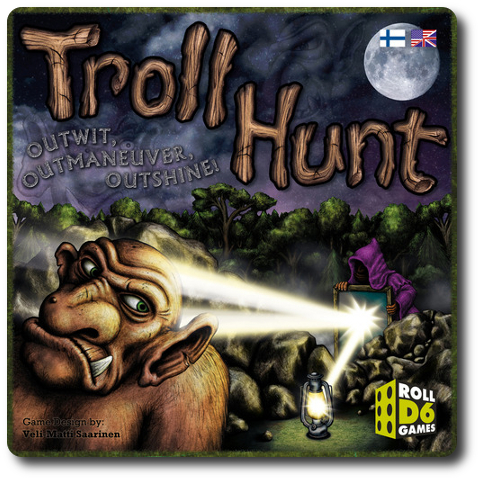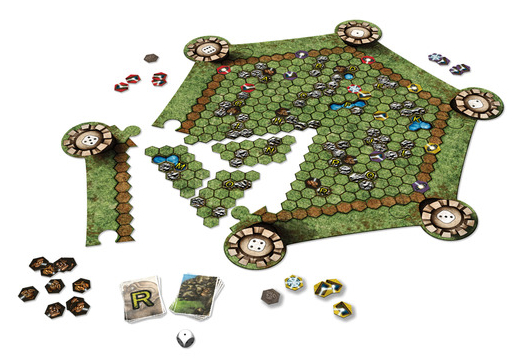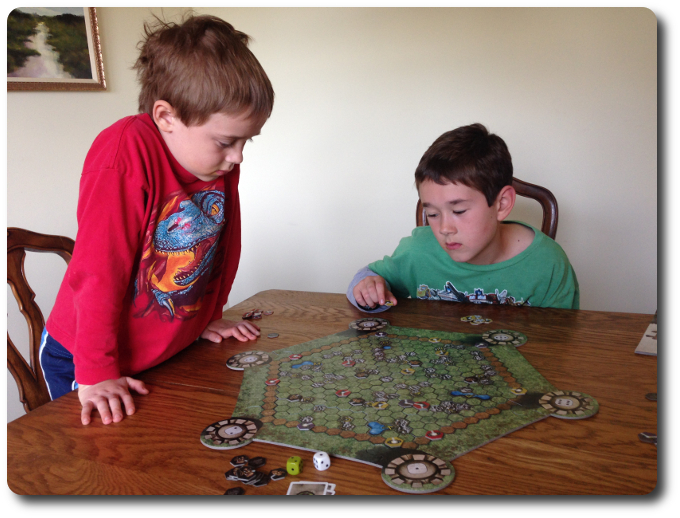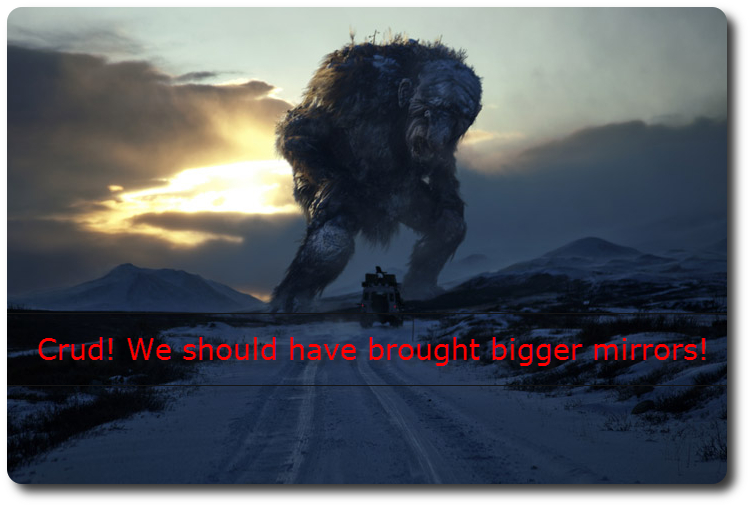
The Basics:
- For ages 7 and up (publisher suggests 8+)
- For 2 to 3 players
- Approximately 45 minutes to complete
Geek Skills:
- Counting & Math
- Logical & Critical Decision Making
- Strategy & Tactics
- Visuospatial Skills
- Hand/Resource Management
Learning Curve:
- Child – Easy
- Adult – Easy
Theme & Narrative:
- Toll hunting is a reflective experience
Endorsements:
- Gamer Geek mixed!
- Parent Geek approved
- Child Geek approved!
Purchase:
Overview
I grew up thinking that Trolls were big, semi-intelligent, and could only be killed using fire. Yes, I was raised on D&D. My Norwegian relatives tell me that Trolls are, in fact, not necessarily evil, but are certainly not very helpful. Everyone seems to have their own point-of-view on Trolls, but one common thread binds them all. No matter where you are from, everyone agrees that Trolls are dangerous. In this game, you will face these monsters, but not directly.
Troll Hunt, designed by Veli-Matti Saarinen and published by Roll D6 Games, is comprised of 18 modular Terrain tiles, 1 Mountain tile, 30 Player tokens (6 Lanterns, 3 Prisms, and 21 Mirrors in 3 different player colors), 18 Troll cards, 1 standard six-sided die, and 6 Tower tiles. The game comes with extra tokens in case some are lost or damaged. The game component quality is excellent. The game board pieces are thick, durable, and fit together snuggly. The cards are as thick as your standard playing card. Visually, the game has enough color to make it interesting, but the overall presentation is not eye-popping. The game is, after all, fairly abstract, requiring the visual presentation to be somewhat less important. Focus is on the game play and token position, not attempting to make your eyes fall in love.

Image courtesy of Game Salute
Prepping for the Troll Hunt
To set up the game, first connect the 6 Tower tiles to form a hexagon. The dice values shown in the tower corners should increase in size when viewed going clockwise.
Second, randomly place the Terrain tiles within the hexagon bordered by the Tower tiles. The only rule when placing the Terrain tiles is that they must all fit within the walls of the Tower tiles.
Third, place the Mountain tile in the center of the game board.
Fourth, have each player select a color of their choice and hand them Lantern, Mirror, and Prism tokens that match their color preference. The number of tokens given is based on the number of players in the game. Any Lantern, Mirror, and Prism tokens not used are placed back in the game box.

From left to right: Mirror token (side A), Lantern token, Prism token (special mirror), and Mirror token (side B)
Fifth, set the Troll tokens aside in a pile. From the pile, separate a specific number of Troll tokens. The number of Troll tokens to separate is based on the number of players. The separated Troll tokens represent the initial trolls to be hunted, seeing the game board.
Sixth, shuffle the Troll cards and place them face-down next to the Troll tokens.
That’s it for game set up. Let’s get some trolls!
Captured by a Beam of Light
Troll Hunt is played in rounds and turns with no set number of rounds in a game. Several game rounds are summarized here, as the focus of the game play changes.
Note: A Prism is really nothing more than a Mirror, albeit a special one. It reflects much more light and scatters it about instead of focusing it like a normal Mirror token. Within the context of the game, wherever “Mirror” is mention in regards to movement and actions, the same applies to the Prism token.
Rounds 1 and 2: Lantern Placement
Players will take turns placing their Lantern tokens on any of the “Sand” terrain located on the border Tower tiles. The turn order for the first round is clockwise. When the last player in the first round places their Lantern token, they start the second round by placing their next Lantern token. Turn order sequence changes to counterclockwise, ending with the first player.
When placing Lantern tokens, players should pay attention to the direction the beam of light is emitting, as Lantern tokens cannot be moved or rotated during the game. Think of this beam of light as a laser that will follow a straight bath until either reflected or stopped. Reflective surfaces like mirrors will bounce the beams in other directions, but obstructions like mountains, trolls, other lanterns, and non-reflective surfaces will stop the beam of light. Rolling meadows, pristine lakes, and gritty sand will not stop a beam of light.
A few rules must be followed when placing the Lantern tokens:
- The beam of light emitting from the Lantern token must point to a Terrain tile.
- No immediate obstructions can be in front of the beam of light.
- Lantern tokens cannot be placed adjacent to an opponent’s Lantern token.
Round 3: Place Initial Trolls
Scattered among the Terrain tiles are a few that have a letter. These are troll spawning points where trolls live. For every Troll token set aside during game set up, the following will now take place. Players can help if they like or only 1 player can complete the following.
- Draw 1 Troll card and reveal its letter value. This identifies the troll spawning point.
- Roll the six-sided die. The die value matches 1 of the 6 Tower tile values. Rotate and place the Troll token so the beam of light indicated on the Troll tile is pointing in that Tower tile’s general direction.
The only restriction when placing a Troll is that it cannot be placed where a beam of light could never reach it. For example, you cannot place the Troll tile so it is facing a rock. Trolls can only be placed on “Sand” or “Meadow” terrains, as well.
The game board is now fully set up and the first rounds of play have been completed.
Rounds 4 and Beyond
Starting in round 4 and continuing for the rest of the game, players will take turns attempting to capture trolls. A player’s turn is summarized here.
Step 1: Select One Action
The first thing a player does on their turn is select 1 out of 2 possible actions to take.
The player can place a Mirror token on the game board which are used to bounce and reflect beams of light being emitted by Lantern tokens. Mirror tokens can be placed on any freely available “Sand” or “Meadow” terrains. They cannot be placed on “Mountain” and “Lake” terrains, nor can they be placed adjacent to an opponent’s Lantern tile. Likewise, a Mirror token cannot be placed so that it breaks an opponent’s link (a continues beam of light emitting from the same colored lantern as the mirrors that are reflecting it). However, Mirror tokens can be used to bounce and reflect an opponent’s beam of light, or the opponent’s mirrors can be used to further the player’s beam of light and goals.

The player’s other possible action is moving their previously placed Mirror token. If the player is moving a previously placed Mirror token, but has not yet placed all their Mirror tokens, they are given 2 Mirror Movement Points to spend. If the player has placed all their Mirror tokens, they are given 4 Mirror Movement Points. Mirror Movement Points can be spent on one or more Mirror tokens, divided among the mirrors as the player sees fit.
Mirror Movement Points are spent as follows:
- Move: For 1 Mirror Movement Point, the Mirror token can be moved to an adjacent space. Mirror tokens cannot move on or through “Mountain” and “Lake” terrain. Hilariously, Mirror tokens can move over other Mirror tokens and Troll tokens as long as the Mirror token doesn’t end its movement on top of either.
- Rotate: For 1 Mirror Movement Point, the Mirror token can be rotated in any new direction.
- Flip & Rotate: For 4 Mirror Movement Points, the Mirror token can be flipped to its other side, changing the angle of the beam. Once flipped, it can be rotated in any direction for free.
Step 2: Turn Trolls to Stone
The player’s Lantern tokens are now activated and the beams of light emitted outwards in the direction indicated on the token. The beam of light is followed by “Line of Sight” using the hex spaces as a guide. If the beam of light is obstructed and fails to hit any of the Troll tokens correctly, the trolls have escaped.
However, if the beam of light has successfully bounced and strikes a Troll token in the eyes, the troll is turned to stone. The Troll token is taken off the game board and placed in front of the player, petrified side up. Only the active player can petrify a Troll token.
Beams of light bounce of any Mirror token (even an opponent’s) as long as the beam of light matches the indicated beam of light path on the Mirror token. In this way, the player can bounce a single beam of light across the game board, around “Mountain” terrain, and into the face of a Troll token. If the beam of light strikes a Prism token, the player will need to follow each beam of light path to determine if any Troll tokens are struck.
The player repeats this process for each of their Lantern tokens. It’s possible to petrify more than 1 Troll token using a single Lantern token.
Step 3: End of Turn
The player adds a new Troll token to the game board for each removed during step 2. This process is a repeat of Round 3 of game play. Discarded Troll cards should be reshuffled when the draw deck is exhausted. If there are no more Troll tokens available during this step or the player failed to petrify any trolls, this step is skipped.
This completes the player’s turn. The next player in turn order sequence now goes starting with the instructions noted for Round 4 above.
Ending the Hunt
The game ends as soon as any player petrifies their 9th (2-player game) or 6th (3-player game) Troll token.
Game Variants
If players are finding the game to be too difficult or too easy, they can adjust the game’s difficulty by completing the following:
- For a longer and more difficult game, increase the number of Troll tokens necessary to win.
- For a shorter and easier game, reduce the number of Troll tokens necessary to win.
To learn more about Troll Hunt, visit the game’s web page.
Final Word
I was very pleased to see the Child Geeks quickly understand the game’s goal and how the beams of light are bounced around using the Mirror and Prism tokens. What was not immediately obvious to any of the players the first time they sat down to learn the game was the importance of the Lantern token’s initial position. If you are familiar with the game Settlers of Catan, you know how important the initial placement of roads and towns is. The same goes for Troll Hunt. Lanterns are the starting point for everything the player does. From there, they move the beam of light around. If the beam of light is put in a bad spot, the player will be spending more time manipulating their Mirrors than taking down Trolls. According to one Child Geek, “If you would have told me to put my Lantern in a better spot, I bet I would have done better.” Another Child Geek said, “This game really makes you think. The only thing you can’t move – and you really want to – is your Lantern token. I wish I had about 10 more.” All the Child Geeks really liked the game’s level of difficult and the freedom to move their Mirrors around. Their favorite part was using an opponent’s Mirror to score a Troll. When all the games were over, the Child Geeks voted to approve Troll Hunt.

My 7-year-old reviews the field, carefully considering his illumination and reflection options
The Parent Geeks enjoyed the game, but kept mentioning how they would prefer it if it took 4 or more players. According to one Parent Geek, “I don’t see why this game only takes 3 players. If you reduced the number of Mirror tokens per player, I bet you could get a fourth Troll Hunter in the game.” That being said, the Parent Geeks enjoyed the game for what it was, liked the game’s abstract game play, the challenge of moving Mirror tokens around, and the sometimes easy and sometimes crazy difficult task of getting a Troll. They also really liked that the game board was always different. According to one Parent Geek, “The fact that the game can always be set up differently makes this really interesting. Just because I was able to bag a lot of Trolls this game doesn’t mean a thing in the next game.” All the Parent Geeks enjoyed themselves and voted to approve Troll Hunt.
The Gamer Geeks were divided. Pretty much all the Gamer Geeks liked what the game was about and the perceived challenge of getting a Troll. Then they found out it was actually really easy to get a Troll. According to one Gamer Geek, “I was ready to really like this game, but I see now that it’s very random and it’s too easy. I’m a bit bored, actually.” Another Gamer Geek said, “The game’s level of complexity is attached to the random game set up, the random Troll placement, and the random moves by your opponents. I cannot really plan anything other than my own move, but I do see that tactics and strategy are necessary to win.” The Gamer Geeks didn’t believe the game was bad by any means, but couldn’t bring themselves to really like it either. One Gamer Geek summed it up very nicely when she said “I like it and I’d play it, but it’s not a game that really grabs my attention and holds on.” The Gamer Geek vote was mixed. The casual Gamer Geeks praising Troll Hunt for its casual strategic and tactical game play. The more hardcore Gamer Geeks found Troll Hunt to be too random, too repetitive, and too light.
I would argue that Troll Hunt is a game in 2 phases. The first is all about positioning, where each player places their Mirror and Prism tokens, slowing populating the game board with more and more mirrors. Players can move Mirror and Prism tokens, but it’s cheaper to add them to the game board versus manipulating the ones already on it. After all the Mirror and Prism tokens have been places, the second phase beings. Now players have to spend all their time moving their Mirrors and Prisms to strike the Trolls, but there’s a problem. The game board is overcrowded with reflective surfaces, making beams of light from Lantern tokens erratically bounce around. The first phase of the game feels like a strategic race where players are attempting to spend as few moves as possible to capture as many Trolls as possible. The second phase is a slow tactical exercise that focuses on limiting opponents and maximizing movement.
Ironically, it’s perfectly possible to win the game during the first phase, essentially skunking the other players. Since the Troll token placement is always random, as is their facing, players might find that they have excellent placement for taking out Trolls with very little effort. I observed 2 games where 1 player won in the first phase without the need of using all their Mirror and Prism tokens. Most of the games last through the first phase and make it into the second phase, with the second phase of the game not taking very long. Which is a good things, because all those Mirrors and Prisms are a pain to visually navigate.
I rather enjoyed myself and can agree with both the negative and positive points provided by our playing groups. I wouldn’t suggest that Troll Hunt is a hardcore abstract game by any means, and that leaves out the gaming elitists. The game is casual and does make use of tactics and strategy. I would suggest the game is somewhere between Checkers and Chess, with moves oftentimes being terribly predictable and other times completely hidden. I like those times, because that’s when the player leans forward and starts tracing all the different ways a beam of light can bounce. That’s when you know when the player is into the game and thinking it through.
I do wish more players could enjoy the game at the same time, but as a 2 and 3-player game, Troll Hunt satisfies. It’s an interesting game that made me think, laugh, roll my eyes, growl, and applaud. I’ll never forget my 3-troll kill with the Prism token. Feels good, man. If you think Troll Hunt sounds like fun, I encourage you to shine some light on the game.

This game was given to Father Geek as a review copy. Father Geek was not paid, bribed, wined, dined, or threatened in vain hopes of influencing this review. Such is the statuesque and legendary integrity of Father Geek.
Discover more from Father Geek
Subscribe to get the latest posts sent to your email.



“Their favorite part was using an opponent’s Lantern beam to score a Troll.”
Actually you cannot use your opponent’s Lantern beam, only your opponent’s mirrors. The one who owns the Lantern, scores the Troll.
Thank you for the nice review!
Thank you very much for taking the time to read my review and identifying an error. You are absolutely correct. Only the active player can use their Lantern, which means opponent Lanterns are considered “off”. Mirrors, regardless of who they belong to, always reflect and bounce beams of light. The active player can use an opponent’ Mirror, but they cannot move an opponent’s Mirror as they would their own.
I have corrected the typo. Thank you again for pointing it out and helping me make the review even better.